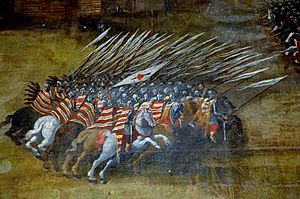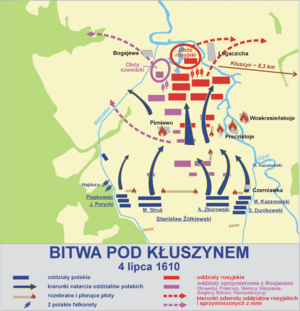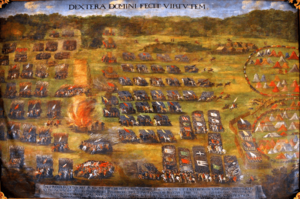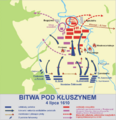Battle of Klushino facts for kids
Quick facts for kids Battle of Klushino |
|||||||
|---|---|---|---|---|---|---|---|
| Part of the Polish–Russian War (1609–1618) | |||||||
 Polish hussar line at the Battle of Kłuszyn |
|||||||
|
|||||||
| Belligerents | |||||||
| Commanders and leaders | |||||||
| Stanisław Żółkiewski | Dmitry Shuisky Jacob De la Gardie |
||||||
| Strength | |||||||
| 6,500–6,800 men 2 guns |
30,000 Russians and 5,000 mercenaries 11 guns |
||||||
| Casualties and losses | |||||||
| 400 | 5,000 | ||||||
The Battle of Klushino (also spelled Kłuszyn) was a major fight on 4 July 1610. It happened between the Polish–Lithuanian Commonwealth and the Tsardom of Russia. This battle was part of the Polish–Russian War. This war was also part of a difficult time in Russia called the Time of Troubles.
The battle took place near the village of Klushino in Russia. Even though the Polish-Lithuanian forces were greatly outnumbered, they won a huge victory. This was thanks to the smart planning of their leader, hetman Stanisław Żółkiewski. It was also due to the amazing skill of the Polish hussars. These hussars were the best cavalry (soldiers on horseback) in the Polish army. The Battle of Klushino is remembered as one of the greatest wins for Polish-Lithuanian cavalry. It shows how strong their army was at that time.
Contents
Why the Battle Happened
In 1610, the Polish-Lithuanian army was moving into Russia. To fight back, Russia and Sweden formed an alliance. They started a military plan called the De la Gardie Campaign. A Russian army, led by Prince Dmitry Shuisky, was heading to help the city of Smolensk. Smolensk was under attack by Polish-Lithuanian forces.
However, Polish-Lithuanian forces, led by hetman Stanisław Żółkiewski, stopped them. Żółkiewski had about 12,000 soldiers. He first met a smaller Russian group of 8,000 men. These Russians quickly built defenses at a camp called Tsaryovo-Zaymishche. Żółkiewski's forces surrounded this camp.
Meanwhile, the main Russian army under Shuisky, with about 35,000 men, was only a few days away. Żółkiewski knew he couldn't fight both groups at once. So, he came up with a clever plan. He left some of his soldiers to keep the first Russian camp surrounded. Then, on 3 July, he took his fastest units, especially his powerful hussars, to surprise Shuisky's main army. This trick worked perfectly. The surrounded Russians didn't know most of the Polish army had left. Shuisky also didn't expect a big fight.
Who Fought: The Armies
The Polish-Lithuanian army had about 6,500 to 6,800 soldiers. About 5,500 of these were the famous "winged" Polish hussars. These hussars were known for their special armor and wings on their backs. Their leader was Hetman Stanisław Żółkiewski.
They faced a much larger force. The Russian army had about 30,000 soldiers. They were led by Princes Dmitry Shuisky, Andrey Galitzine, and Danilo Mezetsky. Russia also had about 5,000 mercenary soldiers. Mercenaries are soldiers who fight for money. These mercenaries came from many countries like France, Germany, and England. They were led by Jacob De la Gardie.
In total, counting all soldiers (even those not directly in the fight), the Polish-Lithuanian side had about 12,300 men. The Russian side had about 48,000. The Polish-Lithuanian army had two cannons. The Russian army had 11 cannons.
The Battle Begins
The battle started before dawn, in the darkness. The Polish-Lithuanian forces hoped to surprise the Russians while they were still sleeping.
The Russian army had their foreign mercenaries on their right side. The main Russian army was in the middle and on their left side. The Russian soldiers were mostly infantry (foot soldiers) hiding behind village fences. They had a second line of cavalry (horse soldiers) behind them. The Russian cannons were left in their camp and didn't fire during the battle.
The Polish-Lithuanian army was mostly cavalry, especially the Polish hussars. They also had about 400 Cossack infantry on their left side. More infantry and two cannons arrived later. They joined the battle after it had already started.
The battlefield was a flat farm field. But it had a tall village picket fence across it. This fence was strengthened with other defenses. This meant the Polish-Lithuanian hussars could only charge through a narrow gap.
The battle began with the Polish hussars repeatedly charging the Russian positions. The Russians were well-defended behind their fences and used firearms. The hussars charged many times, trying to break through. One soldier said his unit charged eight or ten times. These early attacks by the hussars were not successful against the hidden infantry.
Hoping to win, Shuisky ordered his own cavalry, called reiters, to attack the hussars. The reiters tried a tactic called caracole. This meant they would ride up, fire their guns, and then retreat to reload. But the Polish-Lithuanian cavalry didn't retreat. Instead, they charged right into close combat after firing their own guns. This surprised the reiters. The Russian cavalry attack failed badly. This broke the left side of the Russian army. In the confusion, the Russian soldiers started to break ranks and were pushed back towards their camp.
While the center of the Russian army fell apart, the mercenaries on the right side kept fighting hard for several hours. When the Polish-Lithuanian infantry and cannons finally arrived, the mercenaries had to give up their positions. Many of the foreign soldiers managed to retreat in good order. They used their long pikes to protect themselves. They went to the safety of their own fortified camp, which was separate from the Russian camp.
The Polish-Lithuanian forces now surrounded both enemy camps. They also surrounded some mercenaries who had taken positions in a nearby forest. The Russian camp was still strong, filled with soldiers who hadn't fought yet. They still outnumbered the tired Polish-Lithuanian army.
Żółkiewski decided to talk to the enemy instead of fighting more. This worked very well. The foreign mercenaries, left alone by the Russians, agreed to surrender. They were allowed to leave, as long as they promised not to fight for Russia against the Polish-Lithuanian Commonwealth again. Also, several hundred mercenaries chose to join the Polish-Lithuanian army.
What Happened Next
The main Russian army was then allowed to retreat. Shuisky decided not to fight again, even though some of his commanders wanted to. The Polish-Lithuanian soldiers were tired. They were more interested in taking loot (stolen goods) from the camps. They didn't try very hard to stop the retreating Russians. However, some accounts say they did chase the Russians, causing thousands of casualties. The Poles took a lot of valuable things, like gold, silver, furs, and military equipment. They also took all 11 of the Russian cannons and many command flags.
The battle lasted about five hours. Shuisky's army lost about 5,000 soldiers. Żółkiewski's army lost about 400 soldiers, including 100 hussars.
Historians today see this battle as a very important victory in the war. After this win, Żółkiewski went back to the Russians at Tsaryovo-Zaymishche. Their leader, Valuyev, heard about the defeat at Klushino and decided to surrender.
Soon after the battle, the Russian ruler, Tsar Vasili IV, was removed from power by a group of nobles called the Seven Boyars. Żółkiewski then entered Moscow with little resistance. The Seven Boyars then announced that the Polish-Lithuanian prince, Władysław IV Waza, would be the new Tsar of Russia. He claimed the title from 1610 to 1634. But he never actually ruled Russia. His father, the Polish king Zygmunt III Waza, couldn't agree on a lasting deal with the Russian nobles. The Polish-Lithuanian soldiers in Moscow were soon surrounded and surrendered a year later.
The Battle of Klushino is remembered on the Tomb of the Unknown Soldier, Warsaw, in Poland. It has the inscription "KŁUSZYN – MOSKWA 2 VII – 28 VIII 1610".
Images for kids






